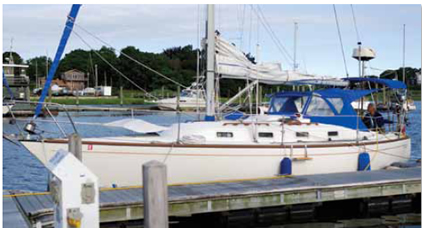
Photo courtesy of Bob Weismantel
382
I just read an editorial in another magazine stating that next year, only low-sulfur diesel will be sold at fuel docks. They went on to say that you can kiss your old diesel goodbye and re-power. I really don’t want to do that. Our 27-year-old M-30 Universal is running just fine. It seems to me that an additive should take the place as a lube that sulfur did for the engine. What is your opinion?
Bob Weismantel
Larina, 1984 Tartan 33
Stony Point, N.Y.
The issue of using low-sulfur diesel in marine engines isn’t a new one. After low-sulfur fuels made their way to the automotive world in 1993 to comply with standards aimed at reducing exhaust emissions, they were eased into the marine market in 2007. Those fuels were 500 parts per million sulfur.
“Prior to 2007, there was considerable buzz in the marine field concerning this reduction of sulfur content, with dire predictions of catastrophic fuel system failures throughout the pleasure and commercial marine market,” explained Doug Rose, of marine-engine manufacturer Volvo Penta. “I would have to say that in general, these fears were greatly overblown. We at Volvo Penta saw little or no increase in fuel system failures.”
However, since 2010, automotive diesel fuels in the U.S. have been required to be Ultra Low Sulfur Diesel (ULSD) formulas, containing 15 parts per million sulfur content—a dramatic reduction. Marine diesel is soon to follow suit. ULSD will come into general use for marine applications in 2012 and should be completely phased in by the end of 2014.
The refinery process for reducing sulfur in diesel does reduce the fuel’s lubricating properties. To combat this, the American Society for Testing and Materials requires that refiners include lubricity additives in the formulas prior to retail sale. According to the diesel industry folks we talked to, because these additives are intended to supply sufficient lubrication, boat owners should not need to add any other additives—even with older engines.
PS diesel consultant Gordon Torresen of Torresen Marine put it simply: “Diesel fuel manufacturers produce fuel that needs no additives.”
Rose agrees; he said it’s a simple case of “If it’s not broke, don’t fix it.” “Today’s engines, and engines built for the past several years, are designed to operate properly on ULSD, and we don’t expect any problems from the new fuel,” Rose said. “In all probability, we won’t see problems with older engines, either.”
For those boat owners who are still skeptical and are looking to use a lubricating additive, talk with your fuel supplier to see what they recommend. They know the standards that have to be met and what has been done to meet those standards.
Another resource worth checking out is www.dieselplace.com. It has information on a test of lubricant additives and offers good background info.

































